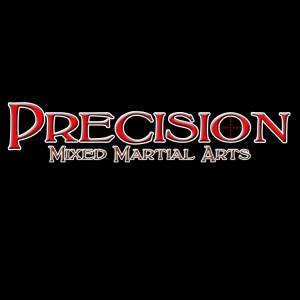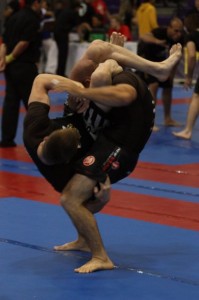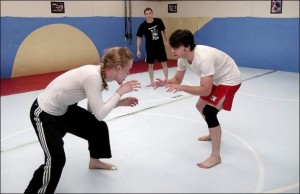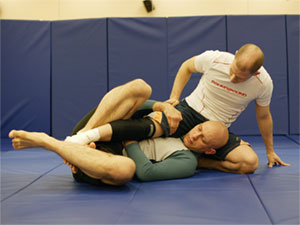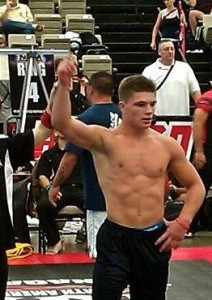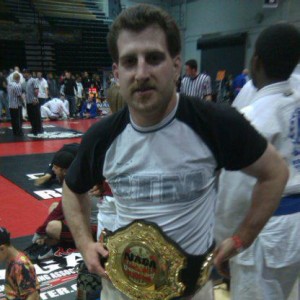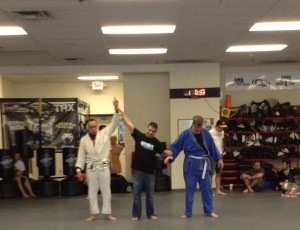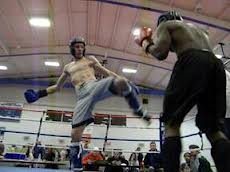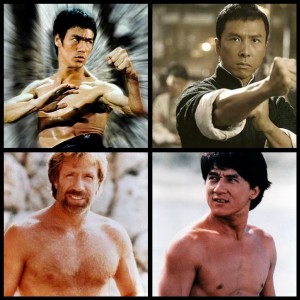Precision Mixed Martial Arts in the Hudson Valley: Compliments and Expands Upon Karate Training

Hudson Valley Martial Arts
Every martial artist in the world starts with a base or “core-style” which they must then build off of. Few who become passionate about the martial arts will train in one style alone throughout their life; most will branch out and experiment with other arts. While the Hudson Valley area of New York does offer a variety of different styles in which to train, like most parts of the United States and perhaps even the world, Karate and its multiple sub-styles is generally the most common. I myself got started in Kenpo, Karate at age eight and continued with it up until I attained my second degree Brown Belt at age fourteen. Like many, I wanted to try out other arts and went on to Brazilian Jiu-Jitsu, and later other styles. Though Karate certainly has its strong points, in general many of its sub-styles neglect ground grappling as well as takedowns and the key elements of boxing head movement and footwork, as well as others. Precision Mixed Martial Arts in the Hudson Valley teaches a number of styles which can compliment and expand upon the Karate background of many students who walk through our doors.
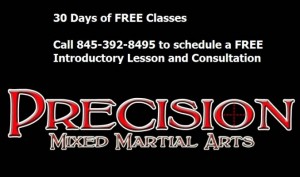
Hudson Valley Martial Arts
As a young martial artist growing up outside the Hudson Valley area I trained daily in Karate. For whatever reason, this style has gained perhaps more notoriety over time than any other and tends to be most frequently the style which young martial artists start off with. While I enjoyed this training and found that it greatly aided my flexibility and kicking ability, I also had certain gripes with it. For example, even as a kid I innately realized that the lack of full contact sparring inhibited my reaction time to attacks. We did include sparring, but the only legal target was the body, and this sadly was not enough for me to learn to apply my techniques in real time. I wanted a martial art like boxing or Brazilian Jiu-Jitsu which would stress full body awareness and reaction time so I would be prepared for attack. After attaining my second degree Brown Belt in Kenpo, Karate at age 14, I stopped and within the next few years became involved in Brazilian Jiu-Jitsu after seeing the great Royce Gracie use it to win the first Ultimate Fighting Championship. I quickly realized how many areas my former style of Karate training had neglected. I had no idea how to defend myself on the ground, nor did I know how to defend myself against takedowns. After a year or two of BJJ I began to grasp these elements for the first time. Brazilian Jiu-Jitsu is, of course, one of the main arts which Precision MMA in the Hudson Valley focuses on. This is quite fortunate for any Karate stylist who decides to train with us. Even the most effective Karate Black Belt will be helpless against a trained Jiu-Jitsuka, or for that matter even an entirely untrained attacker, once the fight hits the ground. The grappling techniques which Precision MMA teaches its students will enable all former Karatekas to expand upon their core striking style so they can defend themselves either standing or on the ground.
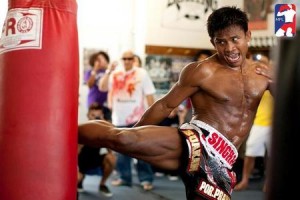
Hudson Valley Martial Arts
Now, if you happen to be a Karate practitioner you may be saying to yourself “if I am ever attacked I want to be able to use my core martial art to defend myself, and would rather stay on my feet than go to the ground.” This is a reasonable stance, and Precision MMA in the Hudson Valley can accommodate this mode of thinking as well. The last range of standing combat, which occurs before the fight must conclude on the ground, is the takedown range, and in order for any Karate practitioner or striker to use their art they must be able to defend the takedown. The two best martial arts for defending against takedowns are wrestling and Judo, and both of these are taught at Precision MMA in the Hudson Valley. We have division one wrestlers who help with our no-gi Jiu-Jitsu classes as well as a world class Judo black belt who aids us in our Gi classes who can show you all the necessary methods for defending different types of takedowns and keeping the fight standing. Indeed, this strategy is quite well known in the world of Mixed Martial Arts today and is often referred to as “sprawl and brawl”. We at Precision of course also teach all around Mixed Martial Arts classes which combine striking with wrestling and Judo, so we can show you how to mix up your striking attacks with your takedown defense and offense in these classes in ways which will expand upon our wrestling and Judo classes as well. However, any Karate stylist who attends Precision in the Hudson Valley will want to be sure to make it to our wrestling and Judo classes so that they can acquire the takedown defense necessary to utilize their prior training. A Karate expert with top notch wrestling and Judo would be a very dangerous opponent for anyone as they would have the tools to keep the fight standing against nearly anyone and use their Karate background, and if they should find themselves on the ground they would also have our Brazilian Jiu-Jitsu techniques to fall back on.
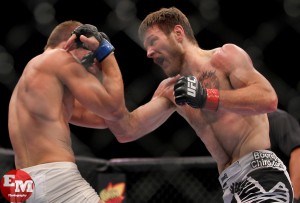
Hudson Valley Martial Arts
Still, Karate as a martial art does not have all of the answers for self defense against standing attacks either and the person who’s entire background consists of what they learned at their local Hudson Valley Karate studio will be lacking when it comes to certain fundamentals common to boxing. Boxing is just one of several martial arts taught at the Hudson Valley’s Precision MMA, but our instructors know how to teach this art in such a way that it will compliment all other styles the student might know. One of our boxing coaches, Jon Russo, has himself also trained in styles such as Taekwondo and Jeet Kune Do, which have quite a few similarities to Karate. As such, he is especially adept at combining his knowledge of these styles with his boxing technique and helping Karate practitioners to add boxing fundamentals to their game. Karate tends to focus on parries and moving blocks as opposed to head movement and footwork to get out of the way of punches like boxing does. While Karate’s defenses can work at times, they are limited when facing a skilled striker and knowing boxing’s methods for defense is very important. Not only this, but as mentioned before, boxing is an art which is almost exclusively done in “real-time” and honed in serious sparring sessions. Therefore, the concern of many former Karate stylists like myself that we may not have developed the proper reaction time to defend strikes is addressed in boxing training and perfectly compliments a Karate background. Likewise, though Hudson Valley Karate schools are likely to teach a number of interesting hand strikes, such as back fists and reverse punches, they are not likely to train their students in the useful punches taught in boxing such as the jab, hook, cross, lead and back hand uppercuts. All of these are addressed at Precision Mixed Martial Arts in our boxing classes and add to the former Karate stylists’ repertoire. Essentially, the boxing classes allow a Karate student to sharpen a weapon they already posses.
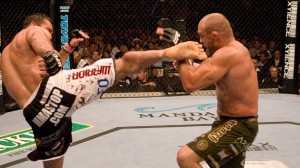
Hudson Valley Martial Arts
Finally, the martial art of Muay Thai Kickboxing as it is taught at Precision Mixed Martial Arts in the Hudson Valley by undefeated 7-0 AKBF champion Karl Nemeth, is the perfect style to compliment a Karate background. I should know as I have found my former Karate training to give me a bit of learning curve when it comes to learning the kicks unique to the Muay Thai style of striking. Though Muay Thai’s kicks are unique from Karate’s, especially in the fact that the striking surface is usually the shin bone rather than the foot, many of the kicks are similar in their motions, particularly the round house and front kicks. As such, former Karate students like myself will not feel completely lost when learning these moves and will simply have to make small adjustments for these kicks to work for them. Also, much like Muay Thai, Karate training tends to greatly stress stretching and leg mobility in order to be able to throw head kicks with ease. My prior Karate training is the reason that I can now achieve a full split, and this has greatly aided me in my ability to fluidly perform the Muay Thai kicks I have learned at Precision MMA in the Hudson Valley. Of course, Muay Thai greatly expands upon Karate training and helps the martial artist to go beyond what his capabilities would have been with the former art alone. For one, Muay Thai training has a very heavy emphasis on clinching techniques which includes both offense and defense against knees and elbows from close quarters, as well as trips. None of these movements are taught in Karate and would make a Karate practitioner very vulnerable in this scenario if fighting a Muay Thai stylist. Also, the Muay Thai clinch is the range of fighting which comes between the punching range and the takedown range, and as such, any former Karate student who wants to learn to defend the takedown and keep the fight standing to use his martial art will need to learn these tactics. Even with the takedown defense acquired from our wrestling and Judo classes and the boxing techniques we teach, a Karateka could be taken down or out struck if he is unable to defend himself in this intermediary range. With Muay Thai clinch training, along with all these other areas we at Precision MMA offer, the former Karate student should have all the tools necessary to compliment his core art. Muay Thai also teaches devastating leg kicks and defense against them, including shin conditioning, which is not taught in Karate. However, anyone who attends Karl’s Muay Thai classes will learn these skills, and a Karate background should make them easier to pick up on. Finally, we put the techniques of all our styles together in our Mixed Martial Arts classes, so if the former Karate student also attends those he will become a truly complete fighter.

Hudson Valley martial arts
Karate practitioners find a home at Precision Mixed Martial Arts in LaGrangeville, New York. Training at Precision MMA not only compliments existing Karate training techniques, but also adds new martial arts dimensions. With all this in mind, Hudson Valley Karate students who transition over to training at Precision MMA need not fear that they have set themselves back by studying a different martial art. To the contrary, Karate has many benefits and can give the Precision student a learning curve when it comes to learning new skills, especially those from Muay Thai. What is paramount is that the new student be open minded and realize that Karate as a style is limited in comparison to the multitude of styles offered at the Hudson Valley’s Precision. If the Karate student recognizes this, he can then move ahead in his training and become a dangerous and multi-dimensional fighter in no time.
To get started with your 30 FREE Days of Hudson Valley martial arts classes visit http://www.poughkeepsiemixedmartialarts.com or call 845-392-8495
About the Author:
Jamey Bazes is a lifelong Hudson Valley martial artist. Jamey holds a brown belts in both traditional Karate and Brazilian Jiu-Jitsu. A regular competitor, Jamey is one of the Hudson Valley’s most decorated martial arts athletes including world titles in the North American Grappling Championship. In addition to his martial arts training Jamey is a graduate of the State University of New York at New Paltz holding a master’s degree in English. To train with Jamey be sure to check out Precision Mixed Martial Arts!






 . Once he retired and put 100% of his efforts into teaching his gym grew exponentially. Today Precision Mixed Martial Arts boasts several hundred students and is home to multiple black belt instructors, as well as golden gloves, muay thai and mixed martial arts champions. There are success stories of everyday men, women and children who have changed their lives through martial arts by learning to defend themselves, gaining discipline and focus, or regaining their health and fitness.
. Once he retired and put 100% of his efforts into teaching his gym grew exponentially. Today Precision Mixed Martial Arts boasts several hundred students and is home to multiple black belt instructors, as well as golden gloves, muay thai and mixed martial arts champions. There are success stories of everyday men, women and children who have changed their lives through martial arts by learning to defend themselves, gaining discipline and focus, or regaining their health and fitness.
